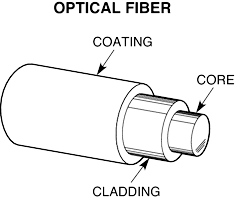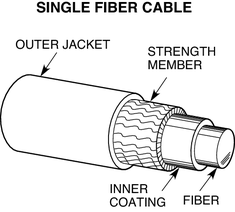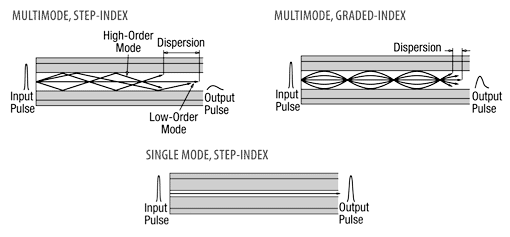Fiber Optic Cable Basics Tutorial
2017-10-06
Abstract
This paper helps you understand the characteristics of different fiber types aides in understanding the applications for which they are used. Fiber optic cables are widely used in fiber optic communications. They are the medium of choice in telecommunications infrastructure, enabling the transmission of high-speed voice, video, and data traffic in enterprise and service provider networks. This paper answers the basics history, and application of fiber optic cables.
What is Fiber Optic Cable?
A fiber optic cable is a is a flexible filament of very clear glass capable of carrying information in the form of light. It is consist of a glass core and cladding, buffer coating, Kevlar strength members and a protective outer jacket. Fiber optic cables are used to transfer digital data signals in the form of light up to distances of hundreds of miles with higher throughput rates than those achievable via electrical communication cables. All fiber optic cables use a core of hair-like transparent silicon covered with less refractive indexed cladding to avoid light leakage to the surroundings. Due to the extreme sensitivity of the optical fiber, it is normally covered with a high-strength, lightweight protective material like Kevlar.


Types of Fiber Optic Cable
The fiber optical fiber can be identified by the type of paths that the light rays, or modes, travel within the fiber core. There are two basic types of fiber: ingle-mode fiber (SMF) and multimode fiber (MMF). Multimode fiber cores may be either step index or graded index. Finished fiber cables can be categorized as outdoor, indoor, or indoor/outdoor.


Single-mode Fiber and Multimode Fiber
Single-mode & Multimode fiber are the two types of fiber in common use. Both fibers are 125 microns in outside diameter – a bit larger than the typical human hair.
Single Mode cable is a single stand (most applications use 2 fibers) of glass fiber with a diameter of 8.3 to 10 microns that has one mode of transmission. Single Mode Fiber with a relatively narrow diameter, through which only one mode will propagate typically 1310,1490 or 1550nm. Carries higher bandwidth than multimode fiber, but requires a light source with a narrow spectral width. Singlemode fiber has the ability to carry a signal for miles, which makes it ideal for telephone and cable television providers. Single Modem fiber is used in many applications where data is sent at multi-frequency (WDM Wave-Division-Multiplexing) so only one cable is needed – (single-mode on one single fiber). Single-mode fiber gives you a higher transmission rate and up to 50 times more distance than multimode fiber, but with a higher cost. Single-mode fiber has a much smaller core diameter of 8.3 to 10 microns than the multi mode. The small core and single light-wave virtually eliminate any distortion that could result from overlapping light pulses, providing the least signal attenuation and the highest transmission speeds of any fiber cable type.
Multimode fiber has a large diameter core of 50 or 62.5 microns that allows multiple modes of light to propagate. Because of this, the number of light reflections created as the light passes through the core increases, creating the ability for more data to pass through at a given time. Because of the high dispersion and attenuation rate with this type of fiber, the quality of the signal is reduced over long distances. This application is typically used for short distance, data and audio/video applications in LANs. RF broadband signals, such as what cable companies commonly use, cannot be transmitted over multimode fiber. The multimode fiber has the following for types for different applications.
OM1, for fiber with 200/500 MHz*km overfilled launch (OFL) bandwidth at 850/1300nm (typically 62.5/125um fiber)
OM2, for fiber with 500/500 MHz*km OFL bandwidth at 850/1300nm (typically 50/125um fiber)
OM3, for a laser-optimized 50um fiber having 2000 MHz*km effective modal bandwidth (EMB, also known as laser bandwidth), designed for 10 Gb/s transmission.
OM4, for a laser-optimized 50um fiber having 4700 MHz*km EMB bandwidth designed for 10 Gb/s, 40 Gb/s, and 100 Gb/s transmission.
Distribution Fiber Optic Cables
This compact building cable consists of individual 900µm buffered fiber, is smaller in size and costs less than breakout fiber cable.The Connectors may be installed directly on 900µm buffered fiber at breakout box locations. The space saving (OFNR) rated cable may be installed where ever breakout cable is used.
Breakout Fiber Optic Cables
Breakout fiber cable consists of several simplex cables bundled together inside a common jacket. Breakout cable enables the quick installation of connectors onto 2+mm robust jacketed fiber, it is a favorite where rugged cables are a desirable or direct termination without junction boxes, patch panels or other hardware is needed. This is a strong, rugged design, but is larger and more expensive than the distribution cables. It is suitable for conduit runs, riser and plenum applications. It’s perfect for industrial applications where ruggedness is needed. Because each fiber is individually reinforced, this design allows for quick termination to connectors and does not require patch panels or boxes. Breakout cable can be more economic where fiber count isn’t too large and distances too long because it requires so much less labor to terminate.
Indoor/Outdoor Fiber Optic Cable
Indoor/outdoor fiber cable uses dry-block technology to seal ruptures against moisture seepage and gel-filled buffer tubes to halt moisture migration.It incorporates the characteristics necessary for both applications. Indoor/outdoor fiber cables are water blocked, sunlight-resistant, and meet one or more of the Code requirements for resistance to flame spread and smoke generation.Comprised of a ripcord, core binder, a flame-retardant layer, overcoat, aramid yarn, and an outer jacket, the indoor/outdoor cable can be run from building to building. Because indoor/outdoor cable is typically plenum-rated, it can be run from equipment room directly to the other equipment room without worrying about fire-safety codes or terminating the cable within 50 feet of the building’s entrance. The cable should be run in a conduit.
Related standards
Below is a summary of selected standards for fiber optics.
· IEC 60793 -parameters of optical fibers and cables:
· IEC 60793-2-10 – applicable to multimode optical fiber types A1a, A1b, and A1d
· IEC 60793-2-50 – applicable to single-mode 9/125 optical fiber types B1.1, B1.2, B1.3, B2, B4, B5
· IEC 60794-2 – requirements for indoor cables
· IEC 60794-3 – requirements for outdoor cables
· ISO/IEC 11801 – specifies general-purpose telecommunication cabling systems (structured cabling), including several classes of optical fiber interconnections (OM1 – OM4, with specified minimum modal bandwidth of 850 nm, and OS1, with attenuation max 1 dB/km)
· ITU-T G.650.1 and G.650.2 – definitions and test methods for linear, deterministic attributes of single-mode fibers and cables,
· ITU-T G.651.1 – characteristics of a 50/125 µm multi mode graded index optical fiber cable…,
· ITU-T G.652 – Characteristics of a single-mode optical fiber and cable (9/125 μm, four versions: A, B, C, D),
· ITU-T G.653 – characteristics of a dispersion-shifted single-mode optical fiber and cable (DS-SMF),
· ITU-T G.654 – characteristics of cut-off shifted single-mode optical fiber and cable (CS-SMF),
· ITU-T G.655 – characteristics of non-zero dispersion-shifted single-mode optical fiber and cable (NZDS-SMF),
· ITU-T G.656 – characteristics of a fiber and cable with Non-Zero Dispersion for Wideband Optical Transport,
· ITU-T G.657 – Characteristics of a bending loss insensitive single mode optical fiber and cable for the access network.
This paper helps you understand the characteristics of different fiber types aides in understanding the applications for which they are used. Fiber optic cables are widely used in fiber optic communications. They are the medium of choice in telecommunications infrastructure, enabling the transmission of high-speed voice, video, and data traffic in enterprise and service provider networks. This paper answers the basics history, and application of fiber optic cables.
What is Fiber Optic Cable?
A fiber optic cable is a is a flexible filament of very clear glass capable of carrying information in the form of light. It is consist of a glass core and cladding, buffer coating, Kevlar strength members and a protective outer jacket. Fiber optic cables are used to transfer digital data signals in the form of light up to distances of hundreds of miles with higher throughput rates than those achievable via electrical communication cables. All fiber optic cables use a core of hair-like transparent silicon covered with less refractive indexed cladding to avoid light leakage to the surroundings. Due to the extreme sensitivity of the optical fiber, it is normally covered with a high-strength, lightweight protective material like Kevlar.


Types of Fiber Optic Cable
The fiber optical fiber can be identified by the type of paths that the light rays, or modes, travel within the fiber core. There are two basic types of fiber: ingle-mode fiber (SMF) and multimode fiber (MMF). Multimode fiber cores may be either step index or graded index. Finished fiber cables can be categorized as outdoor, indoor, or indoor/outdoor.


Single-mode Fiber and Multimode Fiber
Single-mode & Multimode fiber are the two types of fiber in common use. Both fibers are 125 microns in outside diameter – a bit larger than the typical human hair.
Single Mode cable is a single stand (most applications use 2 fibers) of glass fiber with a diameter of 8.3 to 10 microns that has one mode of transmission. Single Mode Fiber with a relatively narrow diameter, through which only one mode will propagate typically 1310,1490 or 1550nm. Carries higher bandwidth than multimode fiber, but requires a light source with a narrow spectral width. Singlemode fiber has the ability to carry a signal for miles, which makes it ideal for telephone and cable television providers. Single Modem fiber is used in many applications where data is sent at multi-frequency (WDM Wave-Division-Multiplexing) so only one cable is needed – (single-mode on one single fiber). Single-mode fiber gives you a higher transmission rate and up to 50 times more distance than multimode fiber, but with a higher cost. Single-mode fiber has a much smaller core diameter of 8.3 to 10 microns than the multi mode. The small core and single light-wave virtually eliminate any distortion that could result from overlapping light pulses, providing the least signal attenuation and the highest transmission speeds of any fiber cable type.
Multimode fiber has a large diameter core of 50 or 62.5 microns that allows multiple modes of light to propagate. Because of this, the number of light reflections created as the light passes through the core increases, creating the ability for more data to pass through at a given time. Because of the high dispersion and attenuation rate with this type of fiber, the quality of the signal is reduced over long distances. This application is typically used for short distance, data and audio/video applications in LANs. RF broadband signals, such as what cable companies commonly use, cannot be transmitted over multimode fiber. The multimode fiber has the following for types for different applications.
OM1, for fiber with 200/500 MHz*km overfilled launch (OFL) bandwidth at 850/1300nm (typically 62.5/125um fiber)
OM2, for fiber with 500/500 MHz*km OFL bandwidth at 850/1300nm (typically 50/125um fiber)
OM3, for a laser-optimized 50um fiber having 2000 MHz*km effective modal bandwidth (EMB, also known as laser bandwidth), designed for 10 Gb/s transmission.
OM4, for a laser-optimized 50um fiber having 4700 MHz*km EMB bandwidth designed for 10 Gb/s, 40 Gb/s, and 100 Gb/s transmission.
Distribution Fiber Optic Cables
This compact building cable consists of individual 900µm buffered fiber, is smaller in size and costs less than breakout fiber cable.The Connectors may be installed directly on 900µm buffered fiber at breakout box locations. The space saving (OFNR) rated cable may be installed where ever breakout cable is used.
Breakout Fiber Optic Cables
Breakout fiber cable consists of several simplex cables bundled together inside a common jacket. Breakout cable enables the quick installation of connectors onto 2+mm robust jacketed fiber, it is a favorite where rugged cables are a desirable or direct termination without junction boxes, patch panels or other hardware is needed. This is a strong, rugged design, but is larger and more expensive than the distribution cables. It is suitable for conduit runs, riser and plenum applications. It’s perfect for industrial applications where ruggedness is needed. Because each fiber is individually reinforced, this design allows for quick termination to connectors and does not require patch panels or boxes. Breakout cable can be more economic where fiber count isn’t too large and distances too long because it requires so much less labor to terminate.
Indoor/Outdoor Fiber Optic Cable
Indoor/outdoor fiber cable uses dry-block technology to seal ruptures against moisture seepage and gel-filled buffer tubes to halt moisture migration.It incorporates the characteristics necessary for both applications. Indoor/outdoor fiber cables are water blocked, sunlight-resistant, and meet one or more of the Code requirements for resistance to flame spread and smoke generation.Comprised of a ripcord, core binder, a flame-retardant layer, overcoat, aramid yarn, and an outer jacket, the indoor/outdoor cable can be run from building to building. Because indoor/outdoor cable is typically plenum-rated, it can be run from equipment room directly to the other equipment room without worrying about fire-safety codes or terminating the cable within 50 feet of the building’s entrance. The cable should be run in a conduit.
Related standards
Below is a summary of selected standards for fiber optics.
· IEC 60793 -parameters of optical fibers and cables:
· IEC 60793-2-10 – applicable to multimode optical fiber types A1a, A1b, and A1d
· IEC 60793-2-50 – applicable to single-mode 9/125 optical fiber types B1.1, B1.2, B1.3, B2, B4, B5
· IEC 60794-2 – requirements for indoor cables
· IEC 60794-3 – requirements for outdoor cables
· ISO/IEC 11801 – specifies general-purpose telecommunication cabling systems (structured cabling), including several classes of optical fiber interconnections (OM1 – OM4, with specified minimum modal bandwidth of 850 nm, and OS1, with attenuation max 1 dB/km)
· ITU-T G.650.1 and G.650.2 – definitions and test methods for linear, deterministic attributes of single-mode fibers and cables,
· ITU-T G.651.1 – characteristics of a 50/125 µm multi mode graded index optical fiber cable…,
· ITU-T G.652 – Characteristics of a single-mode optical fiber and cable (9/125 μm, four versions: A, B, C, D),
· ITU-T G.653 – characteristics of a dispersion-shifted single-mode optical fiber and cable (DS-SMF),
· ITU-T G.654 – characteristics of cut-off shifted single-mode optical fiber and cable (CS-SMF),
· ITU-T G.655 – characteristics of non-zero dispersion-shifted single-mode optical fiber and cable (NZDS-SMF),
· ITU-T G.656 – characteristics of a fiber and cable with Non-Zero Dispersion for Wideband Optical Transport,
· ITU-T G.657 – Characteristics of a bending loss insensitive single mode optical fiber and cable for the access network.
RECENT BLOG POST
-
012019-10With the continuous development of 5G communication technology, 100G modules are gradually becoming popular. We know that there are many kinds of packages for 100G optical modules. From 2000 to now, the optical module package types have been rapidly developed. Its main package types are: GBIC, SFP, XENPAK, SNAP12, X2, XFP, SFP+, QSFP/QSFP+, CFP, CXP. In the fast-developing network era, some 100G optical modules avoid the risk of being eliminated, and upgraded and revised with the wave of the Internet, such as 100G CFP optical modules.
-
012019-101. What is the CWDM SFP? The CWDM optical module is an optical module using CWDM technology to implement the connection between the existing network device and the CWDM multiplexer/demultiplexer. When used with a CWDM multiplexer/demultiplexer, CWDM optical modules can increase network capacity by transmitting multiple data channels with separate optical wavelengths (1270 nm to 1610 nm) on the same single fiber.
-
012019-10AOC is the abbreviation of Active Optical Cables, which is called Active Optical Cables in Chinese. AOC active optical is to encapsulate two optical modules and cable together. Because the medium of transmission in the middle is optical cable, AOC optical module, which contains laser devices, has a higher price for DAC. However, its optical aperture is not exposed, it has high reliability, and its working distance can be customized for a long distance of less than 100 meters.
-
012019-10Dense Wavelength Division Multiplexing (DWDM) technology is capable of transmitting data in an optical fiber using bit wavelength parallel transmission or string line transmission using the wavelength of the laser.It is widely used in different fields of communication networks, including long-distance backbone networks, metropolitan area networks (MANs), residential access networks, and local area networks (LANs).The DWDM optical module is the optical module that uses this technology, so the DWDM optical module has high bandwidth and long-distance transmission characteristics.












